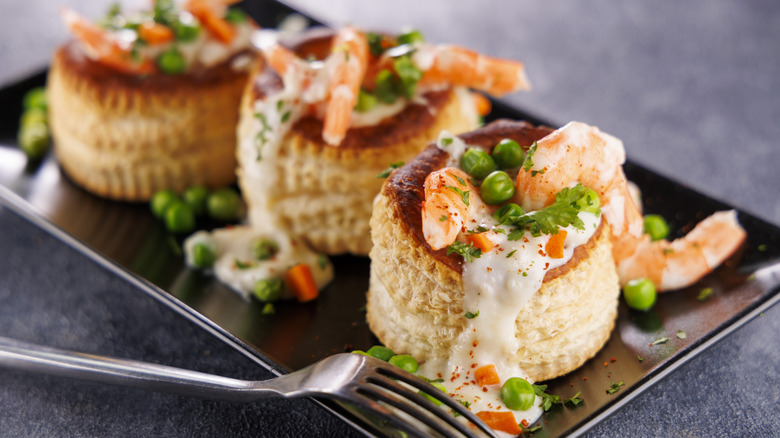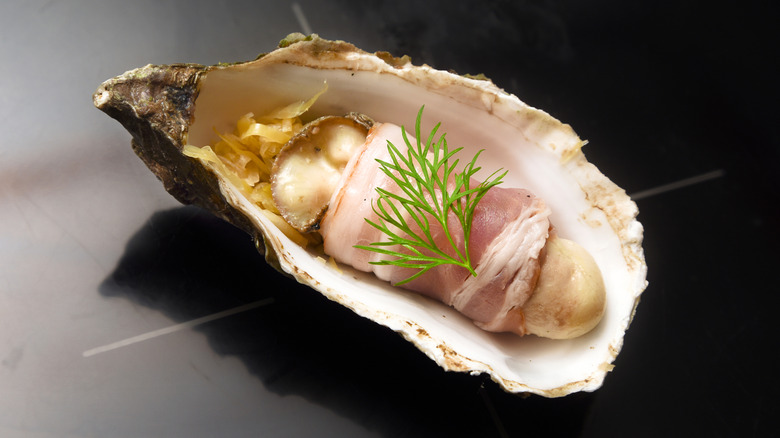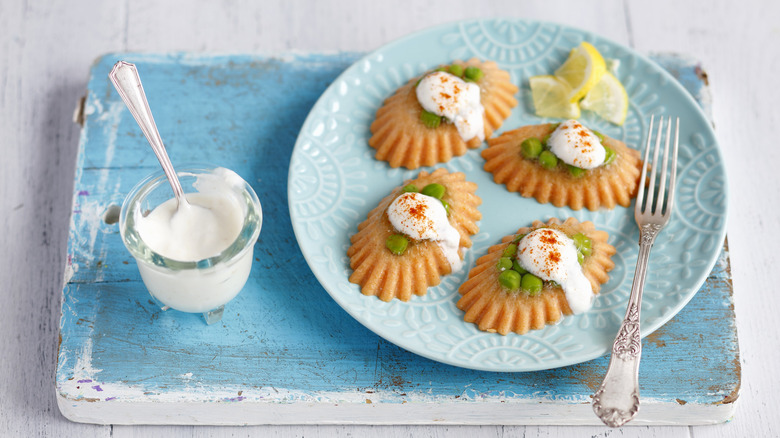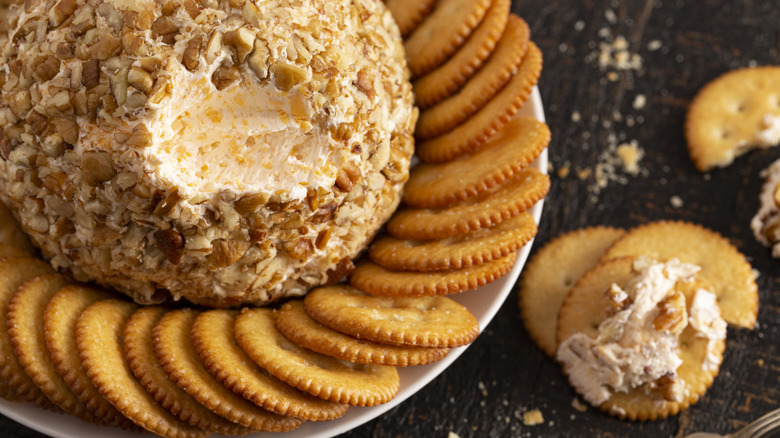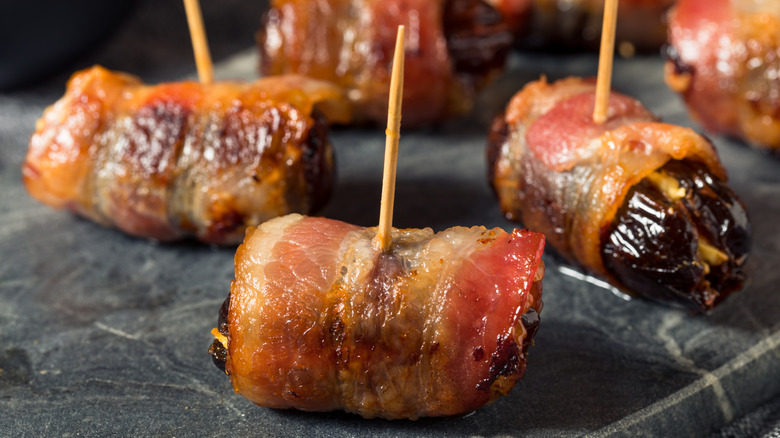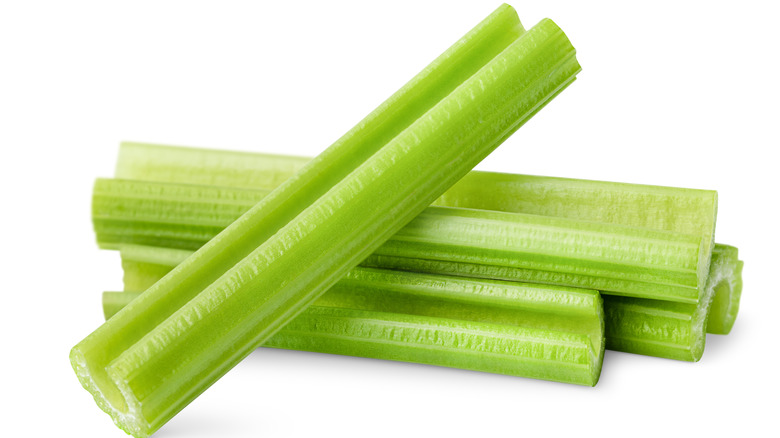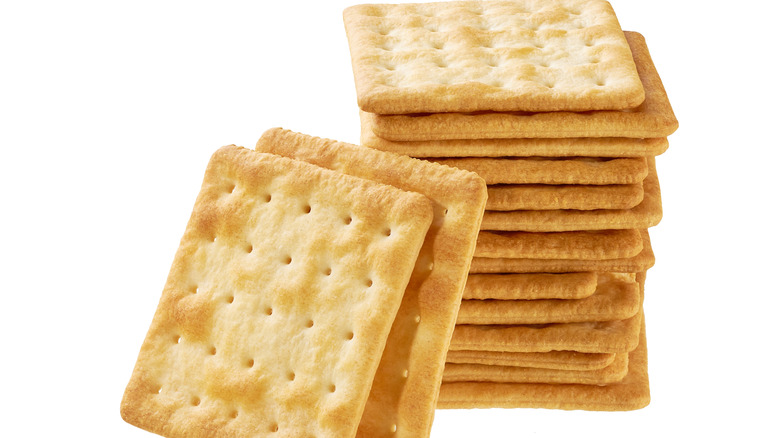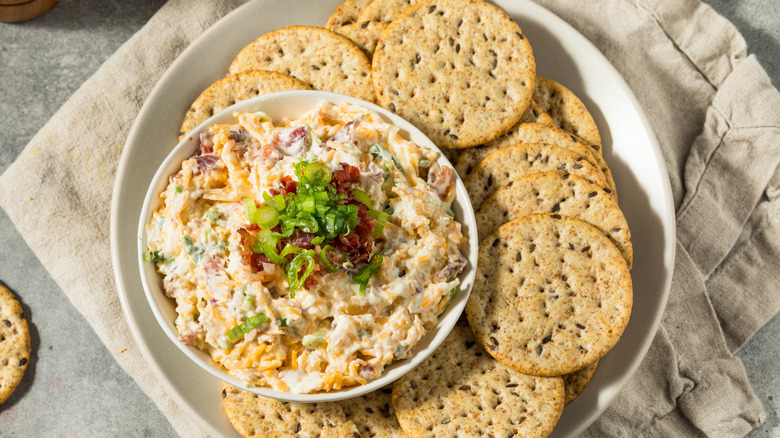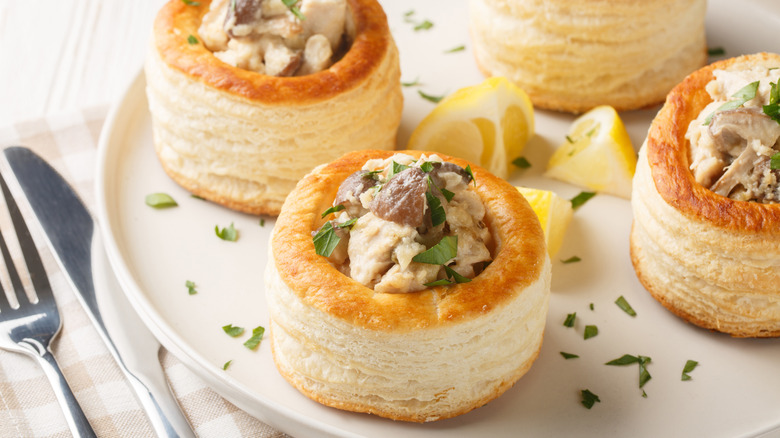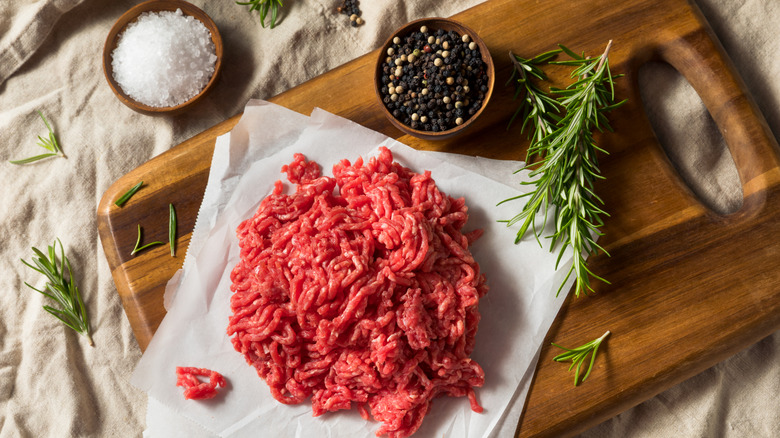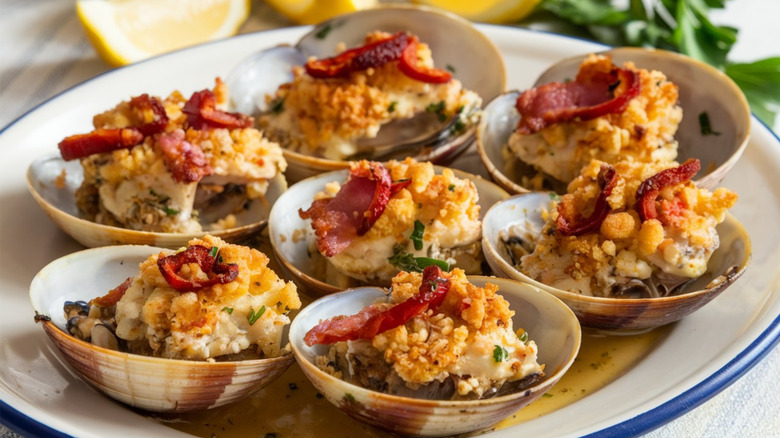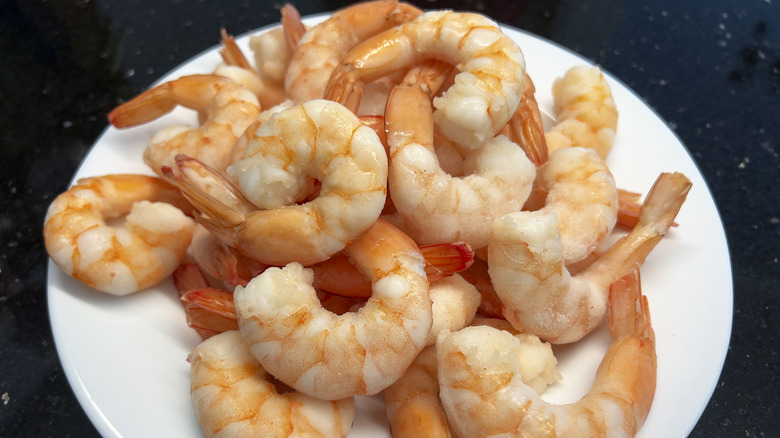Old School Appetizers Almost Everyone Has Forgotten
We may receive a commission on purchases made from links.
Back in the day, appetizers weren't just a prelude to a great meal; they were almost as important as the meal itself. Hosts took great care in crafting the perfect meal starters, and many of them, such as the impressive-looking gelatin molds of the 1970s, even became the party table centerpiece. Everything from fish and hard-boiled eggs to pineapple and cheese was combined with the jiggly stuff to create congealed "salads," such as tuna Jell-O salad — one of the gelatin-based vintage seafood dishes no one eats anymore. Mousses, dips, and spreads took center stage, as did seafood in various forms. Not only did these eye-catching dishes awaken the appetite, but they were often conversation starters, too.
Appetizers became common in American restaurants during the beginning of the 20th century, and were sometimes referred to as relishes or hors d'oeuvres (which literally translates to "outside of the work" in French), especially at more upscale eateries. Going back even further in time, small bites such as olives, eggs, or vegetables were offered as a token of hospitality to guests in ancient Greece and Rome. Throughout the centuries, appetizers have set the tone for celebrations and provided anticipation for the meal ahead. Although today we've moved on to charcuterie boards and garden-fresh salads, these forgotten appetizers of yesteryear deserve to be remembered, and possibly even a spot on the dinner table at your next soirée.
Angels on Horseback
Angels on horseback are a vintage appetizer that may have died and gone to heaven, but at one time, they rode across the fanciest of buffet tables. Traditionally, angels on horseback are made by wrapping smoky bacon around freshly shucked oysters and then broiling them until they're crispy. The delicious, savory bites date back to Victorian England, where people served them as post-dessert palate cleansers or festive hors d'oeuvres at celebrations and get-togethers. The appetizers most likely got their name because the bacon curled when cooked, resembling wings, and the oyster sitting atop its shell looked like a celestial rider.
Prior to the 20th century, oysters were considered "poor man's food," making appetizers featuring them more prevalent on the tables of the working class. This changed as oysters became more expensive, and were considered desirable fare. If seafood isn't your thing, you can try a devil on horseback, which substitutes dates or prunes for oysters.
If you want to try making this heaven-sent appetizer yourself, wrap half-slices of bacon around small shucked oysters to create the perfect one-bite treat. Soaking toothpicks in water and inserting them into the oyster will help hold the bacon in place. Grill or broil the oysters until the bacon is crispy, and splash them with lemon juice. Angels on horseback are commonly served on buttered toast points, which creates an appealing presentation.
Salmon mousse
Silky and savory, salmon mousse was an indulgent appetizer often found swimming on mid-century cocktail party tables. It was typically made with either canned or poached fresh salmon, and then blended with cream cheese or whipped cream, along with a bit of clear gelatin, which held everything together. Seasonings often included herbs that complement fish, such as chives and dill, along with a touch of horseradish for some kick. The mixture was then placed into a mold and chilled in the refrigerator until it was time to serve, when it was commonly set atop green lettuce leaves.
The decadent mousse had almost a velvety texture, and was generally served with fresh lemon wedges and crackers or rye toasts. The salmon mousse could also be nestled in flaky mini vol-au-vents, which are bite-size puff pastry cups. But the element that really makes this appetizer a kitschy retro classic is the fish-shaped mold it often took the form of. The mousse was also sometimes placed into basic ring-shaped molds, but the presentation was still impressive.
Salmon mousse still makes a tasty addition to vintage-inspired party tables, and can be modernized with a splash of hot sauce or a sprinkle of smoked paprika. Serve alongside carrot and celery sticks, slices of French baguette, or crunchy melba toasts.
Homemade cheese balls
Homemade cheese balls burst onto the appetizer scene in the 1950s, and continued to be popular meal starters though the '80s. You can still find them on tables at holiday parties and other types of celebrations, but not as frequently these days. Cheese balls are just what they sound like: cheese shaped into a ball, and served with a variety of crackers for dipping.
Retro cheeseballs are traditionally covered with crushed nuts such as almonds, pecans, or walnuts. Not only do the nuts add to the visual presentation, but they also make the appetizer a bit more substantial and add texture to the soft cheese. The cheesy balls come in handy when you're planning a big party and want to get ahead, as you can freeze them for up to a month if they're properly covered and stored.
The spreadable dip is made by combining cream cheese and mayonnaise, along with a variety of different seasonings and herbs. Some cheese balls contain any combination of salt, pepper, chopped green onions, dill weed, Worcestershire sauce, hot sauce, minced garlic, and shredded cheddar cheese. After the ingredients are well blended, form it into a ball, top with the nuts and even crumbled bacon if you'd like, and chill in the refrigerator until it's served. Don't you agree that it's time for a cheese ball renaissance?
Bacon-wrapped dates
Just like their more heavenly seafood counterpart, angels on horseback, devils on horseback are bite-sized appetizers wrapped in bacon. Instead of oysters, however, devils on horseback contain either prunes or dates, which are sometimes stuffed with cheese or almonds. These cheeky appetizers date back to the 19th century in the United Kingdom, when they were served at the end of Victorian-era parties. As the years progressed, devils on horseback tempted and teased guests' appetites at holiday celebrations and other special events. They especially surged in popularity during the 1960s and '70s.
The allure of this retro appetizer is attributed to its combination of salty, smoky, and slightly sweet flavors, all wrapped in a crispy bacon blanket. Although devils in horseback are indulgent, they're the perfect mouthful when you're awaiting a larger meal.
To recreate these vintage treats at home, slice pitted dates or prunes and stuff them with almonds, blue cheese, or any other ingredient you desire. Wrap stuffed morsels with bacon, hold them in place with wet toothpicks, and bake or fry until they're crispy. To make the devils on horseback even more sinfully delicious, brush a maple syrup and crushed red pepper flake glaze over them.
Olive-stuffed celery
When you think of olives and celery, a bloody Mary may come to mind, but they're also the two main ingredients in a beloved retro appetizer recipe. Olive-stuffed celery entered the party scene in the 1930s, but was a huge hit by the 1960s, and it's no wonder why. The simple yet tasty appetizer features a winning combo of creamy and crunchy textures, as well as a satisfying savory flavor. The salinity of the olives pairs perfectly with the decadent cream cheese, as well as the crunch of the fresh celery.
These easy-to-eat finger foods were a prelude to the main dish at many a vintage cocktail and holiday party, and allowed guests to mix and mingle while they munched. The celery "boats" contain a blend of cream cheese and chopped pimiento-stuffed green olives as a baseline, and sometimes other ingredients such as salt and pepper, chopped pickles and pickle juice, nuts, and mayonnaise for an extra-smooth and luxurious texture.
Olive-stuffed celery is versatile enough to serve on both shiny silver trays at a fancy soirée, or tucked into grandma's relish tray at a casual holiday get-together. If you're craving a nostalgic touch at your next celebration, consider treating your guests to a crunchy bite of culinary history — although it's worth noting that celery is not a calorie-negative food, contrary to popular belief.
Butter-baked saltine crackers
Butter-baked saltine crackers are a simple indulgence, combining two basic kitchen staples into one luxurious snack or appetizer. Legend has it that this winning meal-starter originated in 1972, when sous chef Roderick Moon at the Capital City Club in Atlanta, Georgia, spontaneously tossed saltine crackers with butter when he was out of oyster crackers to serve with soup. Guests loved the crispy, decadent crackers and they became an instant hit, soon appearing on dinner tables all over the South.
Guests at many a social gathering and holiday celebration snacked on these delightfully easy-to-make appetizers for a few decades, until they all but disappeared from the party scene. They're one retro appetizer that deserves a comeback, however, not only because they're tasty, but also relatively inexpensive to make. Even famed chef and cookbook author Ree Drummond bakes saltine crackers to make them better.
To make these rich crackers, simply brush each side of a saltine with melted butter, making sure they're thoroughly coated with the creaminess. You can even pour the butter over the crackers to make sure they're evenly coated, then bake them for a few minutes until they're golden brown. This is where the appetizers' versatility comes in, as you can season them any way you want. Go basic with salt and pepper, or heat things up with a dash of hot sauce or crushed red pepper flakes. The world is your oyster when it comes to this retro appetizer.
Benedictine spread
Creamy and cool, the retro Benedictine spread evokes charming Southern gatherings of yesteryear. A luxurious combination of crisp grated cucumber, thick cream cheese, herbs, and onion, this spread was a common addition to appetizer spreads for decades. Benedictine spread was created by Jennie Carter Benedict, a chef and cookbook author from Kentucky. Her original Southern recipe first appeared in her "Blue Ribbon Cookbook," which was published in 1902. The spread has long been a staple at Kentucky Derby parties, served alongside mint juleps and other appetizers and refreshments.
Benedictine spread is known for its light and fluffy, almost velvety texture, and is traditionally served on crudites or with crackers as an elegant hors d'oeuvres. You can also offer it with fresh vegetables, such as carrot and celery sticks, for dipping, or on crustless white bread as a delicate tea sandwich.
To whip this Kentucky classic up yourself, blend cream cheese, mayonnaise, sour cream, finely grated cucumber, and seasonings to taste. Add a few drops of green food coloring to the mix to achieve the spread's signature hue.
Million dollar dip
Creamy, savory and a bit nutty, smooth million dollar dip is another once-loved vintage appetizer that many people today have forgotten. Originally dubbed the Neiman Marcus Dip, this retro treat was created in one of the Dallas store's restaurants by Helen Corbitt in the 1950s. It features a rich blend of cream cheese, mayonnaise, sharp cheddar cheese, crispy bacon, slivered almonds, and green onions.
This savory spread is simple to make and is traditionally served with buttery crackers and a selection of fresh vegetables, such as carrot sticks. The dip is versatile in that you can use it for scooping, or spreading on crusty bread. Like many other time-tested retro appetizers, million dollar dip offers a delectable mix of textures and flavors. If you happen to be wondering what makes a "million dollar" recipe, here's a hint: It's not the price.
To create the silky texture the dip is known for, beat the cream cheese on a low speed until it's perfectly smooth. Also, to infuse the dip with maximum flavor, toast your slivered almonds in a pan before stirring them into the mixture. You can also heat things up a bit with a dash of hot sauce, or a few shakes of crushed red pepper flakes or cayenne pepper.
Vol-au-Vents
Possibly one of the most elegant forgotten vintage appetizers, vol-au-vents are flaky puff pastry shells that are filled with a variety of creamy delights. These mouthwatering pastries became popular in France during the 19th century, and remained popular party appetizers through the 1980s.
Vol-au-vent is French for "flight in the wind," and is reminiscent of the pastry's light and airy texture. The creation of these classy appetizers is often credited to the famous French chef Marie-Antoine Carême. By the late 20th century, vol-au-vents were considered the epitome of gourmet meal starters, and were often served at stylish cocktail parties and high-class social gatherings. The buttery pastries were typically stuffed with rich and decadent fillings such as creamy soups, mushrooms sauteed in butter, seafood mousses and stews, or chicken in velouté sauce. Vol-au-vents were either served in full-size or bite-size portions, depending on the dinner course and occasion.
If you want to try your hand at making vol-au-vents at home, you can use frozen puff pastry to save time, and fill them with everything from meat and seafood to vegetables and cheese. Mushrooms sauteed in white wine and creme fraiche also makes a decadently delicious filling option — just make sure to buy all-butter puff pastry for the best results.
Hanky pankies
More than just a cute and flirty name, retro hanky pankies were once all the rage at holiday parties and other types of celebrations in the Midwest. They were known as the life of the party, with a name that raised more than a few eyebrows during their heyday. The savory appetizers were popular during the 1970s, and were originally dubbed "Polish mistakes."
Hanky pankies are traditionally made by combining ground beef, spicy sausage, and melty Velveeta cheese into a smooth dip that is baked or broiled to a bubbly perfection. Although they've fallen out of popularity on the party scene, hanky pankies have a nostalgic flavor that would still be welcomed at family gatherings and tailgate parties. Another classic ingredient that makes hanky pankies stand out is Worcestershire sauce, which gives the appetizers a touch of addictive umami. The combination of hearty ground meat, ooey-gooey cheese, savory sauce, and flavorful seasonings makes a satisfying meal-starter for both fancy and casual parties.
To make this retro appetizer, saute the meat in a skillet, drain any excess fat, and add in the cheese, sauce plus any desired seasonings, such as dried oregano, salt, pepper, and garlic powder. The old-fashioned snack is typically served on thin slices of rye or pumpernickel bread.
Clams casino
Although clams casino sounds like a fancy, intricately made dish, the retro appetizer is surprisingly simple to make and delicious to eat. Known as American coastal cuisine, clams casino date back to the early 20th century in New England, featuring a savory mix of clams, breadcrumbs, garlic, bell peppers, and various herbs. The tasty combination is spooned into clam shells and topped with strips of crispy bacon, making for an eye-catching presentation on any cocktail or dinner party table.
The bite-sized appetizers tease your taste buds with an addictive mix of buttery, briny and smoky flavors. The shells are traditionally topped with Parmesan cheese and a squeeze of fresh lemon to cut through some of the richness and add a pop of brightness.
If you want to bring a bit of nostalgic charm to your next dinner party, make clams casino using either fresh or frozen and thawed littleneck clams, depending on what is readily available. The seafood is combined with white wine, clam juice, bacon, panko or breadcrumbs, onion, green pepper, garlic and various seasonings before being spooned into clam shells. Broiling the clams allows the bacon to get crispy, and the breadcrumbs to become golden brown. The finished clams are typically topped with chopped chives for flavor and color.
Shrimp butter
Just the name "shrimp butter" brings to mind visions of decadent hors d'oeuvres from long ago, when starters were every bit as decadent as main courses. A nostalgic nod to mid-century cocktail and dinner parties, shrimp butter is creamy, rich, and highly indulgent.
The traditional recipe, which originated in James Beard's 1972 book "American Cookery" having evolved from his earlier 1940s version, calls for a blend of softened butter, cream cheese, poached raw or canned shrimp, lemon juice for vibrancy, and seasonings such as salt, pepper, and garlic powder. Back in the day, you could find this classy appetizer at everything from fancy holiday parties to bridge nights.
The celebratory snacks were generally served on crunchy saltine or wheat crackers, or rye bread, topped with chopped scallions or a sprinkle of vibrant paprika for color and flavor. Both briny and savory, shrimp butter started classic dinners off on the right note, and the smooth seafood dip is especially appropriate for vintage-inspired New Year's Eve celebrations.
